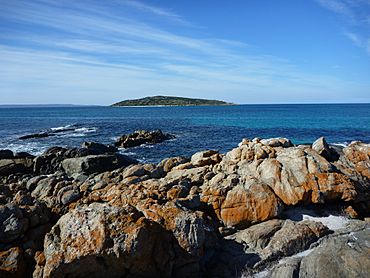Cape Riche facts for kids
Quick facts for kids Cape RicheWestern Australia |
|
|---|---|

Cheyne Island off Cape Riche
|
|
| Location | |
| LGA(s) | City of Albany |
| Region | Great Southern |
| State electorate(s) | Albany |
| Federal Division(s) | O'Connor |
Cape Riche is a special piece of land that sticks out into the ocean, called a cape. You can find it in the Great Southern area of Western Australia. If you drive there, it's about 525 km southeast of Perth and 123 km northeast of Albany. It's part of a bigger area called Wellstead, and it's 24 km south of the main townsite.
At Cape Riche, you'll find useful things like a place to launch boats and a campground. The campground even has flushing toilets and showers, which is great for visitors!
Contents
History of Cape Riche
Cape Riche has a long and interesting history, starting with how it got its name and the people who explored and settled there.
How Cape Riche Got Its Name
Cape Riche was named after a man named Claude-Antoine-Gaspard Riche. He was a naturalist, which means he studied nature. Riche was part of an expedition led by Bruni d'Entrecasteaux in 1791. During this trip, he got lost for two days near Esperance, which is why the cape was named after him.
Early Explorers and Settlers
In 1802, a famous explorer named Matthew Flinders sailed around Australia on his ship, the Investigator. He mapped the area around Cape Riche during his journey.
Later, in 1836, a Scottish immigrant named George Cheyne decided to live at Cape Riche. He had arrived in Albany a few years earlier. George Cheyne set up a trading post, which was like a small shop where people could buy and sell goods. American whalers, who hunted whales, often visited his trading post. Around 1848, people who cut sandalwood trees also came to the area.
Important Visitors and Buildings
In October 1848, John Septimus Roe, who was the Surveyor-General of Western Australia, visited Cape Riche. He was on a big expedition and stayed with the Cheyne family to get more supplies. He left four days later to continue his journey.
The Cheyne family's land was later taken over by the Moir family, who were related to them. The Cape Riche Homestead, also known as Moirs Property, was built between 1850 and 1860 by Alexander Moir. It's a group of large buildings made from a special kind of rock called spongolite.
In the 1870s, people also hunted whales along the coast near Cape Riche. In the 1890s, a schooner (a type of sailing ship) called the Grace Darling would visit every month. It brought supplies and delivered mail between Albany and Esperance.
Nature at Cape Riche
Cape Riche is a special place for nature, with many unique plants and animals.
Special Plants
Many botanists, who are scientists who study plants, have collected plants in the Cape Riche area. Some of these include Ludwig Preiss (in 1840), James Drummond (in the 1840s), John Septimus Roe (in 1848), and William Henry Harvey (in 1854). Later, Ludwig Diels and Ernst Pritzel also collected plants there in 1901.
Some of the plants that were first described from collections made here include:
- Moirs wattle (Acacia moirii)
- Sheath cottonhead (Conostylis vaginata)
- Tallerack (Eucalyptus pleurocarpa)
- Autumn featherflower (Verticordia harveyi)
- Bossiaea preissii
Cape Riche is also home to several rare plant species. These are plants that are not found in many other places and need to be protected. Some examples are the feather-leaved banksia (Banksia brownii), Manypeaks rush (Chordifex arbortivus), Manypeaks sundew (Drosera fimbriata), and coast featherflower (Verticordia helichrysantha).
Amazing Animals
The area around Albany and Cape Riche is known as an important place for southern right whales. These large whales come to this area to have their babies, which is called calving.
Gallery


